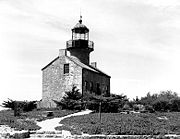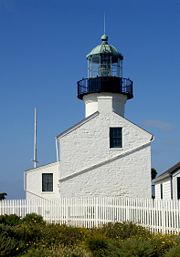.gif)
Point Loma Lighthouse (old)
Encyclopedia
The original Point Loma Lighthouse was built on top of Point Loma at the mouth of San Diego Bay
in San Diego, California
. It is situated in the Cabrillo National Monument
.
was built that year. In 1984, the light was re-lit by the National Park Service
for the first time in 93 years, in celebration of the site’s 130th birthday.
 Historical Information from USCG web site
Historical Information from USCG web site
 Written by Harmon Lougher, Chief Photographer’s Mate, U. S. Coast Guard prior to 1973
Written by Harmon Lougher, Chief Photographer’s Mate, U. S. Coast Guard prior to 1973
"The long neck of land enclosing North San Diego Bay on the West side is known as Point Loma. The origin of the name comes from a legend of a flaxen haired little Russian girl, the sole survivor of a shipwreck, who was found wandering on shore. The local residents took her in and named her Loma and she grew up to become the cynosure of many ardent male eyes. A rejected suitor slew the girl and fled to the point where he met his rival on a narrow trail above the sea. A knife fight ensued and the men fell to their death on the rocks below. Legend has it that Point Loma was named after this girl. Actually the word ‘Loma’ in Portuguese means light." (NOTE: Mr. Lougher was mistaken about this. "Loma" is a Spanish word meaning "hill". The original name of the peninsula was "La Punta de la Loma de San Diego", meaning Hill Point of San Diego. This was later anglicized to Point Loma.)
"Old Point Loma Light—the first lighthouse to be erected in Southern California as distinguished from the present Point Loma Light—was constructed in 1851 and presently being preserved as a memorial. Not used for lighthouse purposes since 1891, the old tower, was set aside by President Wilson in 1913 as a national monument and is now cared for by the U.S. Park Service. The old tower was abandoned because it was situated 462 feet above the sea. At this unusual height, the light was often obscured by high fogs. A romantic error attributes Old Point Loma Light to Spanish origin. When it was built some old Spanish tiles were used in its cellar floorings. That is the full scope of its Latin ancestry. Talk has it that the Spanish had a beacon on Point Loma in 1701, but it has never been verified."
Pathways, surrounded by lush green lawns provide access to three family dwellings and one bachelor quarters. The area is enclosed by a modern concrete block wall. At present, three wives, four children, and five men live in the quarters available."
such as "Captain Israel", a real historical figure who was lighthouse keeper from 1871 to 1892, or "members of the crew" of Cabrillo's
ship. .
San Diego Bay
San Diego Bay is a natural harbor and deepwater port adjacent to San Diego, California. It is 12 mi/19 km long, 1 mi/1.6 km–3 mi/4.8 km wide...
in San Diego, California
San Diego, California
San Diego is the eighth-largest city in the United States and second-largest city in California. The city is located on the coast of the Pacific Ocean in Southern California, immediately adjacent to the Mexican border. The birthplace of California, San Diego is known for its mild year-round...
. It is situated in the Cabrillo National Monument
Cabrillo National Monument
Cabrillo National Monument is located at the southern tip of the Point Loma Peninsula in San Diego, California. It commemorates the landing of Juan Rodríguez Cabrillo at San Diego Bay on September 28, 1542. This event marked the first time that a European expedition had set foot on what later...
.
History
Construction began on the lighthouse in early 1854 and was completed in November 1855. The light was first lit on November 15, 1855. On March 23, 1891 the flame was permanently extinguished, since occasional fogs rendered the lighthouse useless and the Point Loma Light (new)Point Loma Light (new)
New Point Loma Lighthouse is a lighthouse on Point Loma in California,United States, near San Diego, California. It was built in 1891 to replace the Old Point Loma Lighthouse, that was ineffective due to elevation .thumb|left|Undated [[USCG]] photo...
was built that year. In 1984, the light was re-lit by the National Park Service
National Park Service
The National Park Service is the U.S. federal agency that manages all national parks, many national monuments, and other conservation and historical properties with various title designations...
for the first time in 93 years, in celebration of the site’s 130th birthday.

- One of first eight lighthouses on Pacific Coast
- Architect: Ammi B. Young, Department of Treasury
- Contractors: Gibbons & Kelly, Baltimore, Maryland
- Structure completed in 1854
- Third—order Fresnel lens originally intended for Humboldt Harbor installed 1855.
- First lighted November 15, 1855.
- Cost of lens and lantern as purchased from Sautter & Co., Paris, France for $3,810.
- Overall size of third order lens 3.17 foot (0.966216 m) in diameter
- Height of lens was 462 feet (140.8 m) above sea level
- Source of illumination was sperm oil, colza, lard oil, kerosene
- Distance visible was 28 miles (45.1 km)
- Lighthouse deactivated on March 23, 1891 and lens removed
- Lighthouse structure restored by National Park Service in 1935.
- Fourth order lens from Humboldt Harbor (Table Rock Light) (1.5 feet in diameter) loaned to NPS by United States Coast GuardUnited States Coast GuardThe United States Coast Guard is a branch of the United States Armed Forces and one of the seven U.S. uniformed services. The Coast Guard is a maritime, military, multi-mission service unique among the military branches for having a maritime law enforcement mission and a federal regulatory agency...
in 1955. On exhibit in Old Point Loma Light from 1955 to May 1981 and returned to Coast Guard, May 1981. - Third—order Fresnel lens (from Mile Rock Light) loaned to Cabrillo National Monument in May 1981.
- Lens transfer (off—loading from CG Cutter Rush) was scheduled for Wednesday, May 20, 1981
- Lens will be on display in Cabrillo National Monument Visitor Center until lighthouse tower and lantern is restored and can safely accommodate third—order lens.

"The long neck of land enclosing North San Diego Bay on the West side is known as Point Loma. The origin of the name comes from a legend of a flaxen haired little Russian girl, the sole survivor of a shipwreck, who was found wandering on shore. The local residents took her in and named her Loma and she grew up to become the cynosure of many ardent male eyes. A rejected suitor slew the girl and fled to the point where he met his rival on a narrow trail above the sea. A knife fight ensued and the men fell to their death on the rocks below. Legend has it that Point Loma was named after this girl. Actually the word ‘Loma’ in Portuguese means light." (NOTE: Mr. Lougher was mistaken about this. "Loma" is a Spanish word meaning "hill". The original name of the peninsula was "La Punta de la Loma de San Diego", meaning Hill Point of San Diego. This was later anglicized to Point Loma.)
"Old Point Loma Light—the first lighthouse to be erected in Southern California as distinguished from the present Point Loma Light—was constructed in 1851 and presently being preserved as a memorial. Not used for lighthouse purposes since 1891, the old tower, was set aside by President Wilson in 1913 as a national monument and is now cared for by the U.S. Park Service. The old tower was abandoned because it was situated 462 feet above the sea. At this unusual height, the light was often obscured by high fogs. A romantic error attributes Old Point Loma Light to Spanish origin. When it was built some old Spanish tiles were used in its cellar floorings. That is the full scope of its Latin ancestry. Talk has it that the Spanish had a beacon on Point Loma in 1701, but it has never been verified."
New Point Loma Light
In 1891 the current iron skeleton tower of the present Point Loma Light was built on the extremity of the point with the light only 88 feet (26.8 m) above the water. Point Loma has a 600,000 candlepower light which can be seen a distance of approximately 15 miles (24.1 km). In addition to the light, there is a two-tone diaphone fog signal, which, when operating in inclement weather, is synchronized with a radio-beacon every three minutes for distance finding. The skeleton frame of the light surrounds an enclosed stairway to the tower platform, where the lantern is located. At the base of the structure is the fog signal building.Pathways, surrounded by lush green lawns provide access to three family dwellings and one bachelor quarters. The area is enclosed by a modern concrete block wall. At present, three wives, four children, and five men live in the quarters available."
The lighthouse today
Today the lighthouse is no longer in service but still stands as a landmark and museum. Visitors may enter the lighthouse and view parts of the living quarters there. Visitors are sometimes greeted by volunteer historical re-enactorsHistorical reenactment
Historical reenactment is an educational activity in which participants attempt torecreate some aspects of a historical event or period. This may be as narrow as a specific moment from a battle, such as the reenactment of Pickett's Charge at the Great Reunion of 1913, or as broad as an entire...
such as "Captain Israel", a real historical figure who was lighthouse keeper from 1871 to 1892, or "members of the crew" of Cabrillo's
Juan Rodríguez Cabrillo
Juan Rodriguez Cabrillo was a Portuguese explorer noted for his exploration of the west coast of North America on behalf of Spain. Cabrillo was the first European explorer to navigate the coast of present day California in the United States...
ship. .

